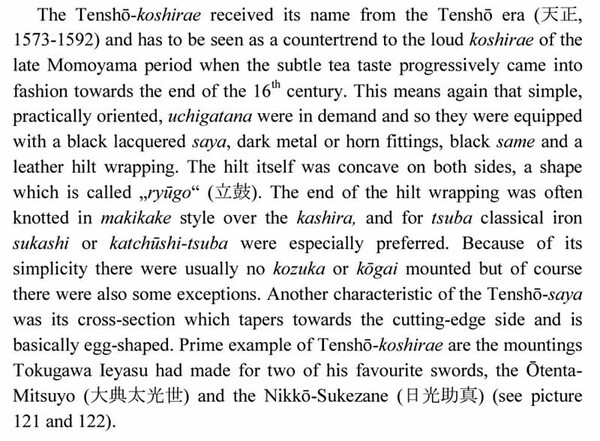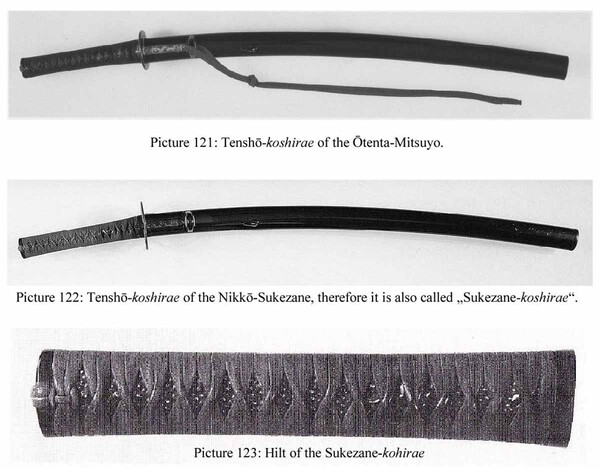-
Posts
1,029 -
Joined
-
Last visited
Everything posted by Eric H
-
After a bit of research, a Tanto by Hayama Enshin, this supports the statement by Chris Bowen...but what about the Koshirae ? http://www.samuraishokai.jp/sword/11604.html Eric
-
Seems to be a Tachi from early sword period. The Tsuba (toran kei?) and the Fuchi are made as a „one piece“ to be fixed to the blade with a mekugi. The blade has high shinogi with a kissaki in shobu zukuri style, but there is no mune to see. Muji hada? - difficult to judge. Hamon starts just where the Habaki -missing now - ends. Condition and appearance of this Tachi of unusual shape and the Koshirae leave no other conclusion than that it is a historic sword of early time. Shape: the translation says imprecisely "tweezers, nippers) shape. This Tachi is not for sale but for „Reference“ only and the note „Tokyo 140629) could point to a Museum in Tokyo. Eric
-
Firstly as has been pointed out experienced Japanese have another approach to swords. Best examples are the Hachimonji-Chogi in old polish and the shodai Tadayoshi.The first doesn‘t need a new polish and for both papers are obsolete. The comments by Chris Bowen and Mike Y. affirm between the lines the advantage of papers, and it is true when paulb points to the significance of papers for western collectors, also in relation to the inheritants, who will be thankful to get a well documented collection in hands. I think papers are a bit more than a learning tool, they confirm the authenticity of the mei and this gives a rough guide of the commercial value of the sword, but as said, swords are valued one by one, i.e. Kiyomaro's skill has had a wide range as I remember a comment by Guido Schiller. Arnold F‘s comment on the history of „papering“ is interesting, as well the challenge with mumei blades, in this field only the Japanese experts are decisive. I recall a recently happened incident where a longtime German collector tried to sell a gakumei Norishige at Koller Zurich, estimated between US$ 62,000 / 83,000. Koller was forced to withdraw the sword due to my stubborn intervention. As said, the existence of a paper is an important device as well as the non-existence of a paper when in relation to a famous name. Eric
-

Norishige at Koller Zurich
Eric H replied to Eric H's topic in Sword Shows, Events, Community News and Legislation Issues
The arguments by Chris Bowen and Mariusz K are correct and reveal in some aspects the weak points of this sword... Lot 367 Katana Norishige - Estimate CHF 60‘000 / 80‘000 - is withdrawn and removed from the auction-site. Eric -

Norishige at Koller Zurich
Eric H replied to Eric H's topic in Sword Shows, Events, Community News and Legislation Issues
This Norishige is gimei, a fake, and should be withdrawn immediately from the auction. Eric -
Jean, The pic by Richard George is Muromachi era koshirae. The Muromachi koshirae you have posted on the other forum, according to the Zufu paper... „its handle is wrapped in a style known as kangi-maki with black leather and the menuki are completely covered by the wrap“... (nihonto.com) from Sesko book e-koshirae Eric
-
Daisho Uchigatana Koshirae Harima Honda Family Kunitaro san, An exquisite and important Daisho-Koshirae and as I believe with a documented history. Unfortunately without the blades, and in connection with this topic, were the blades made by the same smith intentionally as a pair or made by different smiths? Eric
-
Daisho, by its origin it means a „pair of swords“ -big and little-... it was the symbol of the Samurai class. Later on „daisho“ became also to be a synonym for identically mounting i.e. koshirae. Purist collectors nowadays claim that a „true“ daisho consists of the matching koshirae and swords by the same smith with matching date. The 47 Ronin and their Swords http://home.earthlink.net/~steinrl/ronin.htm some excerpts from Sesko e-book koshirae Eric
-

Submitting blades for Shinsa
Eric H replied to CurtisR's topic in General Nihonto Related Discussion
The Examination Regulations of NBTHK Shinsa are clearly defined in: Kōeki zaidanhōjin Nihon bijutsu tōken hozon kyōkai shinsa kitei Swords with hagire are not papered: Example Masayuki (Kiyomaro) Katana, Christie‘s Sale 2007/05/16, Lot 0420... but Sayagaki by Tanobe Michihiro. The midareba hamon of the Muramasa Tanto with its very shallow valleys, almost touching the edge, is a trade mark of nidai Muramasa. The Tokubetsu Hozon designation is now and furthermore correct. The formerly mentioned Tadayoshi III Wakizashi was sent for Shinsa in November 2007. The Hozon status it was given is correct. There are swords by important smiths with „solely“ the Hozon designation, and I recall a sword that was priced in Japan against $ 500‘000 with Hozon paper. A well known phrase used by sword dealers: „It has NBTHK Hozon papers attesting to its condition and quality“ Eric -
eBooks are very easy and comfortable to deal with. I have the following ebooks by Markus Sesko from Kindle and Lulu: Kindle: The Art of the Japanese Sword Genealogies and Schools of Japanese swordsmiths Lulu: e-Koshirae-Japanese Sword e-Index of Japanese Swordsmiths e-Koto-Kantei e-Shinto & Shinshinto Kantei Today is 40% off today‘s order. Get the chance... :D Eric
-
Another example „Bishu Osafune Yasumitsu“ without date http://www.aoi-art.com/sword/katana/11538.html Eric
-
-
-
Well it‘s the kanji „Ju“ that stands for Longevity *KOTOBUKI* Obviously there are numerous varieties in styling possible for this kanji. Usually when painted on a Kakejiku they are represented one-hundred-times. Eric
-
KOTOBUKI - Longevity numerous kanji in archaic style depicting always the same kanji on a Kakejiku and Tosogu. Eric
-

Pic of Miyamoto Kanenori.包則
Eric H replied to k morita's topic in General Nihonto Related Discussion
Also, there are a lot of fakes of his work, just like those of his contemporary, Gassan Sadakazu. One needs to take care when buying. The following article is from the UK Sword Register. Unfortunately my Webarchive is not able to transmit the entire article to the web. This chinese forgery of a Kanehiro sword is quite sophisticated, so I think that Clive Sinclaire has hopefully no objection when a „part“ of the article is published on the NMB. Otherwise it can be deleted. Eric -

Pic of Miyamoto Kanenori.包則
Eric H replied to k morita's topic in General Nihonto Related Discussion
George, The "explanation" is from the Token Bijutsu (TB) Summer 1983 (Kanzan Kiyoshitsu). The magnified pic is not from the Kanenori Tanto, it‘s an example that shows ostentatiously outstanding hada containing glittering elements and is crude in appearance. Matsukawa hada is a kantei point. Eric -

Pic of Miyamoto Kanenori.包則
Eric H replied to k morita's topic in General Nihonto Related Discussion
I think this is in accordance with his workmanship in his later days. The Tanto, 17 cm, displaying hadamono was made when his was 80 years old, in 1909. Explanation of hada-mono and yakumo-gitae. Eric -

Pic of Miyamoto Kanenori.包則
Eric H replied to k morita's topic in General Nihonto Related Discussion
His workmanship Katana 69.6 cm http://www.bushidojapaneseswords.com/kanenoridaito.htm Tanto 17 cm Eric -
Why should I be offended? Anybody on this Board is free to speak out his opinion. However I believe to Chris Bowen, who has seen thousands of swords and participated at numerous Kantei sessions during his stay for many years in Japan as I recall. That said his experience in this field is proven. I for one listen carefully to his opinion. Eric
-
A kantei point is like a signpost: presence of mizukage point either to Horikawa Kunihiro or Sendai Kunikane, both Keicho-Shinto smiths, or could be the result of saiha, retempered.... but Kunihiro has also other kantei points, namely his kitae of large and loose grain called zanguri-hada, or Horikawa hada. I add a pic of TB 31, the PERIODIC APPRECIATION MEETING „the most important clue in the blade is the mizukage-like utsuri“ as also „and his zanguri texture of steel surface is typical enough to indicate the Horikawa craftsmanship“ Eric
-
A kantei point is a trait which is found in the forge of a smith, if it is unique to this smith, it is sufficient to itself. If it belongs to several smiths, then you have to add all the particularities of a sword (kantei points) and by elimination you will find the smith. So the ware are a kantei point when all the other kantei points are there. Best explained by Jean. I give another example of a strong kantei point: mizukage seen sometimes on blades by Horikawa Kunihiro, however it must be in accordance to other well known characteristics, equally regarded as important kantei points, seen in his works. Mizukage otherwise is a sign of saiha. Eric
-
If so than this is very seldom seen as I have not heard of it, i.e. to be a trait of Norishige or Den Norishige. I add a pic from my database of a Norishige Katana that exhibits 2 small kizu which follow the grain structure. Eric
-

Original prices of gendai-to (and shinshin-to)
Eric H replied to Bruno's topic in Military Swords of Japan
Excerpt from a lecture by Professor Lia Baretta (Italy) "After five months he was offered a three-year contract with a monthly salary of 450 yen and a house; this was one of the highest salaries paid to a foreigner...(1875)" Edoardo Chiossone Museum, Genoa Eric



































